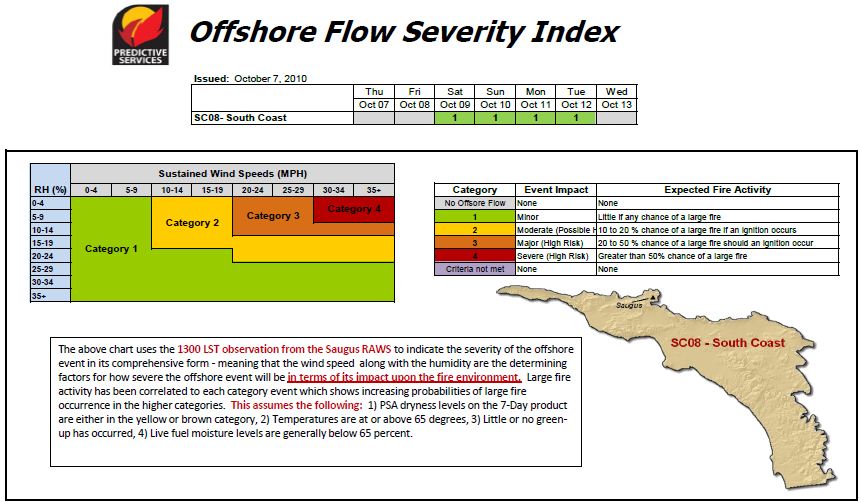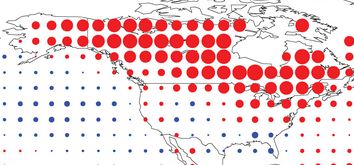If you saw this, what would you do?

From National Geographic
News and opinion about wildland fire

A new tool is available that predicts the severity of Santa Ana winds in southern California six days in advance. Called the Offshore Flow Severity Index, it combines the relative humidity with the 1:00 p.m. wind speed predicted at the Saugus weather station to rate the events each day on a scale from one to four, with four being the highest. A category four event requires winds in excess of 30 mph with a relative humidity of less than 9%.
The term “offshore” is used because Santa Ana winds usually blow from a high pressure area over the Great Basin to a low pressure area off the southern California coast. These north, northeast, or east winds blow from the land to the ocean, or “offshore”, warming and drying as they move from high elevations to coastal elevations. Many of the larger and most devastating wildfires in southern California have occurred during offshore or Santa Ana wind events.
This forecasting tool will enable wildfire managers to modify their staffing or move fire resources into areas as needed to deal with the potential for large fires.
================
UPDATE: October 26, 2011. Access to the site now requires a password, which seems very odd.
We have seen recent videos of fire whirls, such as the one HERE, but a video that recently surfaced of wind rotation over a fire near the Pohakuloa Training Area on the Big Island of Hawaii is very impressive. There is no way I would want to be anywhere near a potentially lethal situation like the one in the video below. It was shot on Sunday by the Department of Land and Natural Resources.
When you watch it, click on full screen (the little symbol next to the speaker icon), and also listen to the audio.
(The video is no longer available)
Did you notice that the firefighters in the white fire truck got out of there as soon as they saw what was going on? And eventually the photographer did too. Smart move.
We have ranted about San Diego Gas and Electric a number of times for starting numerous wildfires, including the disastrous Witch, Rice, and Guejito fires in eastern San Diego County in 2007. But we have to give them credit for doing two things recently that benefit the wildland fire community.
The first was the purchase of a $30 million Erickson Air-Crane S64F Helitanker that should be delivered later this month. The company has agreed to share it with San Diego County on wildfires for a reasonable cost, but it will be used primarily for constructing and maintaining power lines.
The second thing they have done is to install a boatload of weather stations in the backcountry areas of San Diego County, including Ramona, Alpine, El Cajon, Valley Center and Fallbrook. So far they have have installed 94, yes 94, weather stations on power poles in wind-prone areas. The solar-powered stations contain sensors and data loggers made by RM Young and Campbell Scientific, respectively, and monitor wind speed, wind direction, temperature, and relative humidity.
SDG&E intends to use the data from the stations to determine where it should stage repair crews and whether or not it should shut off power to residents during periods of strong winds.
The meteorologists in the local National Weather Service office are pretty excited about this massive new source of weather conditions. SDG&E has plans to make the data available to the public through a “dashboard”.
The National Oceanic and Atmospheric Administration has concluded that the first six months of this year were the warmest ever recorded for the combined global land and ocean surface temperatures.
The map below zooms in on North America and shows that areas in the western half of the United States were either one degree C above or below average, while the northeast, Canada, and Alaska were about three to four degrees C above normal for the first six months of this year.

Two years ago residents of Barrow, on Alaska’s North Slope, saw something they had never seen on the North Slope–lightning. Climate change is bringing lightning, and lightning-caused fires to northern Alaska in quantities never before seen in recorded history. Here is an excerpt from an article at usnews.com.
When it comes to weather, it’s hard to impress the Iñupiat people living at the northernmost tip of our nation. Frozen landscapes, cutting winds, and white-outs are normal in Barrow, Alaska, a small town on the Arctic Ocean about 1,300 miles from the North Pole. But two summers ago, even the oldest residents were startled by something new: flashes of light and powerful booms coming from the sky.
“These people had never seen a lightning storm at Barrow before,” says Gaius Shaver, an Arctic ecologist from the Marine Biological Laboratory’s Ecosystems Center in Woods Hole, Mass. “They didn’t know what to think.”
With temperatures warming an average of 3 to 5 degrees over the past half-century, the climate on the North Slope of Alaska is in transition. Warmer air means more energy is available for thunderstorms where, once, it was just too cold. And more lightning is bringing another dramatic change to the tundra: Wildfires.
“The decade of the 2000s was, by far, the biggest for fires on the North Slope in half a century,” Shaver says. Thirteen wildfires torched nearly 260,000 acres over the decade—more than all the fires recorded and area burned on the North Slope since 1950. And as global warming continues, tundra wildfires are fully expected to increase, both in frequency and acreage burned.
The implications of fire in the Arctic—what Shaver calls “a new disturbance regime”—are profound. “Fire may be the trigger that shifts the North Slope landscape into a new state,” Shaver says—one vastly different from the frozen, treeless tundra of today. And it’s one that may feedback positively to global climate change.